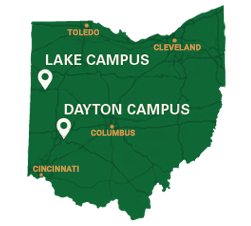Occupational and Environmental Training
Request Training
For access to training courses, additional training topics, or general questions complete the EHS Request for Service.
Integral to promoting a safe and healthy campus, Wright State University's Environmental Health and Safety (EHS) offers occupational and environmental training to Wright State University employees and students. EHS has over 100 training topics available for the university community.
Most laboratory research trainings are offered through CITI training and other Occupational Training is available at AIG RiskTool Advantage.
Training Courses
The list below contains several of the most frequently required EHS training topics for the university facilities, laboratory, and research personnel.
- Aerial Lift
- Ammonia Use (Ice Room)
- Animal Biosafety (Occupational Health for Animal Users)
- Asbestos Awareness
- Autoclave Safety
- Initial Biological Safety
- Biological and Biosecurity Safety Training (CITI)
- Biological Safety Cabinets
- Bloodborne Pathogens
- Chlorine Use for Water Treatment
- Cold Weather Injury Prevention
- Confined Space
- Contractor Safety and Health
- Environmental Health and Safety Orientation
- Electrical Safety
- Fall Protection
- Forklift Safety and Operation
- Fume Hood
- Hazard Communication
- Hearing Conservation
- Heat Stress
- Lab Chemical Safety
- Lab Safety for Non-Laboratory Personnel
- Ladder Safety
- Laser Safety
- Lock Out/Tag Out
- Radiation Generating Equipment (RGE) Initial and Refresher Training
- Radiation Safety: Safe Use of Radioactive Materials (RAM)
- Radiation Safety Awareness
- Respiratory Protection
- Safe Handling of Pyrophoric Materials
- Scaffolding
- Shipping Hazardous Materials
- Spill Prevention Control and Countermeasures (SPCC)
- Storm Water Management
- Waste Management
- Welding Safety
Self-service Registration Instructions
To get started, follow these instructions:
Access the CITI website, then select "Register Here" to set up your account.
The first step on the registration page is to select your institution. Please select "Wright State University".
Once you set up your account, you will be prompted to answer a series of questions that will determine which training courses you need. The courses/modules that are required for you will now be listed on the "Learner's Menu" page under "My Courses" page.
Aerial Lift
Describes hazards associated with working on mechanical elevating devices and safe operating procedures. Includes a hands-on requirement to operate a lift
Ammonia Use (Ice Room)
Describes hazards of ammonia, protective measures, ventilation requirements, systems monitoring, and emergency procedures for working with ammonia in the ammonia ice chiller room
Animal Biosafety: Occupational Health and Safety for Animal Users
Describes potential hazards, protective strategies, emergency procedures, and medical surveillance required when working directly with animals
Asbestos Awareness
Describes hazards of asbestos, possible locations, and protective measures to prevent exposure
Autoclave Safety
Describes safety procedures and practices for using laboratory autoclaves.
Initial Biological Safety
Describes health risks of those who are involved in research use of biological material including information on risk assessment, personal protective equipment, and emergency procedures.
Biological Safety Cabinets
Describes the proper selection and use of the various types of biological safety cabinets. These cabinets are essential in protecting both the lab worker and the research when used appropriately.
Bloodborne Pathogens
Introduces the University’s Exposure Control Plan including information on universal precautions, hazards, labels, housekeeping, spill response, and what to do if you are exposed
Chlorine Use for Water Treatment
Describes hazards, protective measures, emergency procedures, ventilation, and monitoring of the chlorine room at the Water Treatment Plant
Cold Weather Injury Prevention
Describes hazards and protective strategies to prevent hypothermia or other cold weather-related issues
Confined Space
Describes confined spaces, recognition of potentially harmful atmospheres and physical hazards, protective measures, and emergency procedures
Contractor Safety and Health
Describes the environmental and safety expectations for contractors performing work on campus
Environmental Health and Safety Orientation
Introduces the university’s EHS program as required by local, state, and federal regulations. Topics include fire extinguisher use, emergency preparedness procedures, hazard communication, injury/illness prevention program components, pollution prevention, and personal safety on campus
Electrical Safety
Describes general hazards and strategies to protect yourself from the hazards of electricity
Fall Protection
Describes how to recognize hazards, protection devices, and procedures for working at heights
Forklift Safety and Operation
Describes the potential hazards and hands-on operation of a forklift
Fume Hood
Describes procedures and practices for the safe use of chemical fume hoods
Hazard Communication
Introduces the university’s Hazard Communication Program including information on hazardous material inventorying, hazard identification, labeling, and safety data sheet (SDS) use
A PowerPoint presentation is available for supplemental information. Hazard Communication (HAZCOM) Training (PPTX)
Hearing Conservation
Introduces the university’s Hearing Conservation Program and provides techniques to maintain effective control over the harmful effects of excessive noise. Includes information on the use of personal protective equipment and the university’s occupational health program for hearing
Heat Stress
Describes the hazards and protective strategies to prevent heat stress, heat exhaustion, or other heat-related issues
Laboratory Safety
Introduces the university's Laboratory Safety Manual which includes the recognition and mitigation of laboratory hazards; the use of engineering controls, administrative controls, and personal protective equipment; working safely with chemicals, the use of safety data sheets (SDSs), procedures for disposing of hazardous waste, and fire safety precautions for the laboratory
Lab Safety Awareness for Facilities Operations Personnel
Provides information on the general hazards associated with entering and/or performing non-lab type work in a university laboratory. This course covers all material required for:
- Hazard Communication Training
- Radiation Safety Awareness
Ladder Safety
Provides information on the hazards, safety, and proper policies of working on ladders
Laser Safety
Provides information on personal and departmental responsibilities, laser classification, hazards, laser controls, and safety equipment associated with Class 3b or Class 4 laser use
Lock Out/Tag Out
Provides information on protection from the accidental startup of machines or equipment and to prevent the release of stored energy during servicing and/or maintenance. Energy sources include electrical, mechanical, hydraulic, pneumatic, chemical, thermal, electromagnetic, radioactive, kinetic (moving), potential (gravity), or other energy sources
Radiation Generating Equipment (RGE) Initial and Refresher Training
Introduces the university's Radiation Safety Program for the use, handling, and storage of radiation-generating equipment (RGE) as required by the Ohio Administrative Code (OAC)
Radiation Safety - Safe Use of Radioactive Materials (RAM)
Introduces the university's Radiation Safety Program Provides information on the use, handling, and storage of radioactive materials (RAM) and applicable Ohio Department of Health rules
Radiation Safety Awareness
Provides information on the general hazards associated with entering and/or performing non-lab type work in a university laboratory that uses radioactive material (RAM) or radiation generating equipment (RGE)
Respiratory Protection
Introduces the university’s Respiratory Protection Program including information on the safe use, limitations, selection, fit testing, medical surveillance, and the proper care of respirators
Safe Handling of Pyrophoric Materials
Describes laboratory safety practices, including how identifying, storage, use of PPE, and handling procedures for pyrophoric materials, like butyl lithium
Scaffolding
Describes the hazards associated with working from scaffolds and the proper erection of scaffold systems
Shipping Hazardous Materials
Describes the proper packaging, labeling, documentation, and hazards associated with the shipping and receiving of hazardous materials
Spill Prevention Control and Countermeasures (SPCC)
Introduces the university’s EPA-required Spill Prevention Control and Countermeasures Plan and describes how to prevent and respond to spills of oil and oil-related products
Storm Water Management
Introduces the university’s Stormwater Management Permit and activities allowed, and not allowed, under the permit. Includes information on illicit discharges to the storm sewer, planning, design, and maintenance of areas to prevent stormwater pollution, and prevention techniques
Waste Management
Describes the university's waste management practices, including classification, packaging, labeling, storage, recordkeeping, and information on the EPA rules covering hazardous waste
Welding Safety
Describes the safe operation and use of equipment, hazards, protective measures, and process (system) for welding operations

